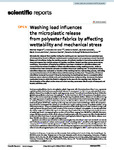Washing load influences the microplastic release from polyester fabrics by affecting wettability and mechanical stress
| dc.contributor.author | Volgare, M | |
| dc.contributor.author | De Falco, Francesca | |
| dc.contributor.author | Avolio, R | |
| dc.contributor.author | Castaldo, R | |
| dc.contributor.author | Errico, ME | |
| dc.contributor.author | Gentile, G | |
| dc.contributor.author | Ambrogi, V | |
| dc.contributor.author | Cocca, M | |
| dc.date.accessioned | 2021-11-15T12:59:44Z | |
| dc.date.issued | 2021-09-30 | |
| dc.identifier.issn | 2045-2322 | |
| dc.identifier.issn | 2045-2322 | |
| dc.identifier.other | 19479 | |
| dc.identifier.uri | http://hdl.handle.net/10026.1/18364 | |
| dc.description.abstract |
<jats:title>Abstract</jats:title><jats:p>Microplastics released from textiles during the washing process represent the most prevalent type of microparticles found in different environmental compartments and ecosystems around the world. Release of microfibres during the washing process of synthetic textiles is due to the mechanical and chemical stresses that clothes undergo in washing machines. Several washing process parameters, conditions, formulations of laundering additives have been correlated to microfibre release and some of them have been identified to affect microfibre release during washing process, while no correlation has been evaluated between microfibre release and washing load. In the present study, microfibre release was evaluated as function of the washing load in a real washing process, indicating a progressive decrease of microfibre release with increasing washing load. The quantity of released microfibres increased by around 5 times by decreasing the washing load due to a synergistic effect between water-volume to fabric ratio and mechanical stress during washing. Moreover, the higher mechanical stress to which the fabric is subjected in the case of a low washing load, hinders the discrimination of the effect on the release of other washing parameters like the type of detergent and laundry additives used.</jats:p> | |
| dc.format.extent | 19479- | |
| dc.format.medium | Electronic | |
| dc.language | en | |
| dc.language.iso | en | |
| dc.publisher | Nature Research | |
| dc.subject | Bioengineering | |
| dc.title | Washing load influences the microplastic release from polyester fabrics by affecting wettability and mechanical stress | |
| dc.type | journal-article | |
| dc.type | Journal Article | |
| dc.type | Research Support, Non-U.S. Gov't | |
| plymouth.author-url | https://www.webofscience.com/api/gateway?GWVersion=2&SrcApp=PARTNER_APP&SrcAuth=LinksAMR&KeyUT=WOS:000702737500016&DestLinkType=FullRecord&DestApp=ALL_WOS&UsrCustomerID=11bb513d99f797142bcfeffcc58ea008 | |
| plymouth.issue | 1 | |
| plymouth.volume | 11 | |
| plymouth.publication-status | Published online | |
| plymouth.journal | Scientific Reports | |
| dc.identifier.doi | 10.1038/s41598-021-98836-6 | |
| plymouth.organisational-group | /Plymouth | |
| plymouth.organisational-group | /Plymouth/Faculty of Science and Engineering | |
| plymouth.organisational-group | /Plymouth/Faculty of Science and Engineering/School of Geography, Earth and Environmental Sciences | |
| plymouth.organisational-group | /Plymouth/Users by role | |
| plymouth.organisational-group | /Plymouth/Users by role/Academics | |
| dc.publisher.place | England | |
| dcterms.dateAccepted | 2021-08-17 | |
| dc.rights.embargodate | 2021-11-16 | |
| dc.identifier.eissn | 2045-2322 | |
| dc.rights.embargoperiod | Not known | |
| rioxxterms.versionofrecord | 10.1038/s41598-021-98836-6 | |
| rioxxterms.licenseref.uri | http://www.rioxx.net/licenses/all-rights-reserved | |
| rioxxterms.licenseref.startdate | 2021-09-30 | |
| rioxxterms.type | Journal Article/Review |


